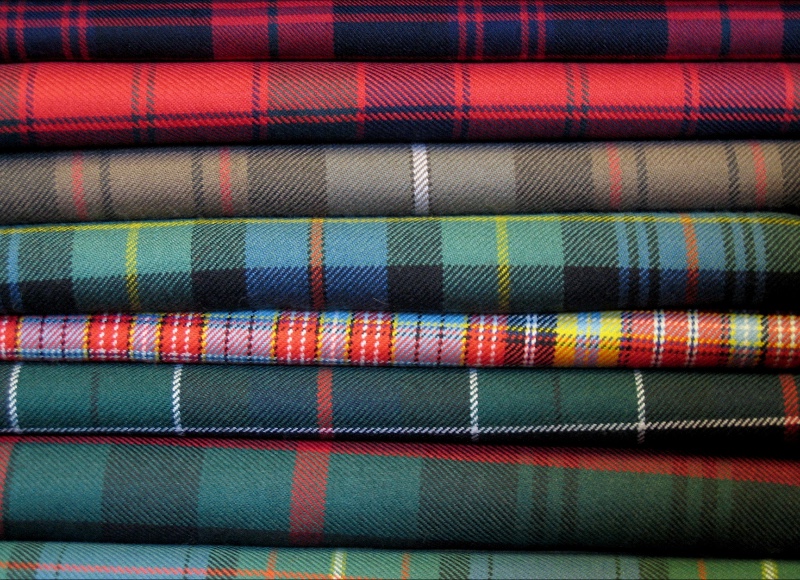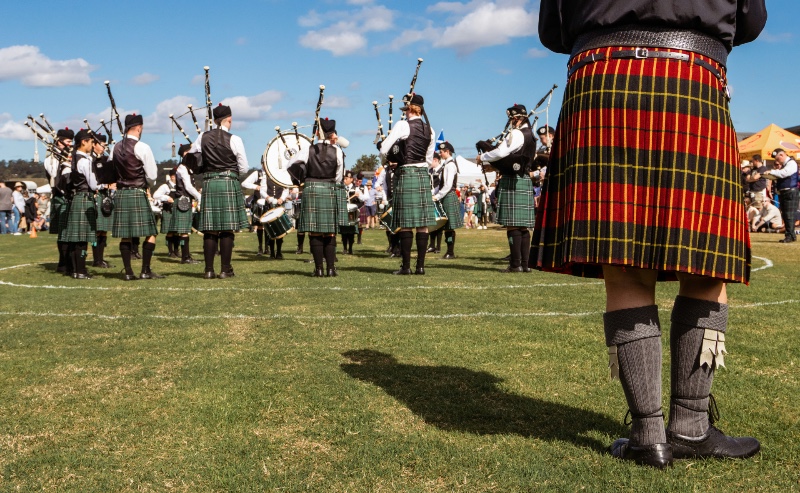Tartan Fabric: A Complete Guide
Tartan is a distinctive fabric, instantly recognisable by its criss-crossed, multi-coloured patterns of vertical and horizontal stripes. When people hear the word 'tartan', they often think of Scottish kilts, bagpipes, and the rich traditions of Scotland. Woven in wool or wool blends, tartan has deep roots in the history and identity of Scotland. For centuries, it has been more than just a cloth—it’s a symbol of belonging, a marker of heritage, and a proud emblem worn during Highland Games, national celebrations, and family occasions.

What Is Tartan?
At its simplest, tartan is a patterned textile created by weaving together coloured threads in both the warp (lengthwise) and the weft (crosswise) to produce a checked design. These repeating patterns are called “setts,” and each one is unique, often associated with a particular Scottish clan or region.
The term “tartan” refers specifically to the fabric, while the word “plaid”—often confused with tartan—originally referred to a large length of tartan cloth worn as a cloak or blanket. In North America, however, “plaid” has become a common term for any tartan-like pattern.
There are different types of tartan, each with its own history and purpose. The main types include ancient, modern, hunting, dress, and weathered tartans. For example, the Black Watch tartan is a well-known type that has both modern and hunting variations. These types often feature a mix of patterns and colours, reflecting the diverse heritage and evolving styles within tartan design.
A Brief History of Tartan
The history of tartan dates back many centuries. Early examples of checked cloth have been found across Europe, but it is in Scotland that tartan became deeply embedded in cultural identity. By the 16th century, tartan patterns were widespread in the Scottish Highlands, with different areas producing their own variations.
Over time, these patterns became linked with specific clans—extended family groups with shared ancestry. The spelling of Scottish surnames has changed throughout history, with names like Murray originally spelled as Morrey, which can affect the matching of tartans to family names. Although the direct connection between tartans and clans was formalised mainly during the 19th century Victorian revival of Highland culture, the tradition is now a proud part of Scottish heritage.
The word “tartan” is derived from the French tiretaine, but the cultural significance is deeply tied to the Scottish Gaelic tradition. In Gaelic, tartan is known as breacan, which means “speckled” or “particoloured.” Tartan became an expression of Highland identity and, after the Jacobite uprisings, a target of suppression—banned under the Dress Act of 1746. The ban was lifted in 1782, and tartan soon enjoyed a resurgence. The year 1746 marked a turning point, and later years such as 1822, when King George IV's visit to Scotland greatly boosted tartan's popularity, and 1848, when Queen Victoria purchased Balmoral Castle, further strengthened tartan's royal associations.
The Victorian revival of Highland culture brought tartan to the forefront of Scottish identity. After this period, King George IV's visit to Scotland in 1822 played a significant role in popularizing tartan among both Scots and the British royal family.
Tartan’s enduring popularity is a testament to the rich heritage and tradition of Scotland.

How Tartan Is Made?
Tartan is traditionally produced on a loom using dyed wool yarns. Weavers follow precise colour sequences for each sett, ensuring the design is symmetrical and consistent. Each colour stripe crosses over and under another to form a grid where new shades can appear from the overlapping threads.
Tartan fabrics can be made from a variety of materials, including wool, cotton, and synthetic fibers. Modern tartans are often woven from blends such as polyester and wool, which offer durability, versatility, and easy maintenance.
The quality of the wool, the tightness of the weave, and the skill of the weaver all affect the final result. Today, tartans are still woven by specialist mills in Scotland, often using traditional methods handed down over generations. The Scottish Register of Tartans maintains a database of thousands of registered patterns, including many modern creations alongside ancient designs.
Tartan and Clan Identity
Scottish clans have long been at the heart of tartan tradition, with wearing tartan serving as a way for individuals to express allegiance to a particular clan. Famous tartans include those of the Macdonald, Campbell, and Macleod clans, among many others. Perhaps the most well-known of all is the Royal Stewart tartan, associated with the House of Stewart—the royal dynasty that once ruled Scotland and later the whole of Great Britain.
Scottish clans were often born of social ties rather than just blood ties, meaning that membership could be based on loyalty, residence, or service as much as on direct lineage.
Tartan can be found in kilts, scarves, sashes, and trews, often worn during Highland Games, weddings, ceilidhs, and formal events. Each pattern carries with it a sense of pride and connection to Scottish ancestry, even for those who live far from Scotland’s shores. Today, millions of people around the world feel a strong connection to tartan and Scottish heritage.
Modern Uses and Global Influence
While tartan has ancient roots, it remains fashionable today. Designers around the world have adopted tartan patterns into everything from haute couture to punk-inspired streetwear. Whether it’s a nod to heritage or a bold fashion statement, tartan continues to evolve.
Today, there is an incredible choice of tartans available, with thousands of patterns to select from, allowing individuals to find the perfect design for their needs. Many people and companies can create their own unique tartans for personal, commercial, or commemorative purposes, making tartan design highly customizable. Online tools make it easy to find your clan or tartan, and you can search for tartans by surname, clan, or place, such as a specific Scottish city or district. Some of these tartan design tools are free, letting you experiment and design without cost. Universal tartans are also available, which anyone can wear regardless of heritage. Many retailers keep a large stock of tartans for immediate purchase, and you can visit online or physical stores to explore extensive tartan collections.
In Scotland, tartan is an ever-present symbol of national pride. From the athletes at the Highland Games to ceremonial attire for pipers and dancers, tartan brings a sense of tradition and continuity to modern Scottish life.
Why Is Tartan So Hard-Wearing?
Tartan’s durability comes from both the material it is made from and the method used to produce it. Traditionally woven from wool, a natural fibre known for its strength and resilience, tartan is designed to withstand tough conditions—ideal for life in the Scottish Highlands, where harsh weather and rugged terrain are part of everyday life.
Tartan fabric is also commonly used for home decor items such as curtains and upholstery, valued for its durability and timeless style.
Wool has several properties that make it ideal for a hard-wearing fabric:
Elasticity: Wool fibres can bend and stretch without breaking, allowing tartan to retain its shape and resist wear over time.
Natural lanolin coating: This gives wool a degree of water resistance, helping tartan garments like kilts and plaids shed light rain and stay dry longer.
Insulation: Wool traps air, providing warmth even when damp—a vital quality for outdoor clothing in Scotland’s unpredictable climate.
The weaving technique also contributes to tartan’s strength. Traditional weavers use a twill weave, where the yarns are woven in a diagonal pattern that gives the cloth added flexibility and toughness. This construction, combined with the density of the weave, helps tartan resist fraying and tearing even under heavy use.
In many tartan patterns, red and white are key colors, especially in traditional and dress tartans, where they contribute to the distinctive and festive appearance of the fabric.
It’s no coincidence that tartan was historically worn by Highland warriors, outdoor labourers, and herders—it was made to last, move, and protect.
Tartan in Schools
Many Scottish schools incorporate tartan into their uniforms, especially in private or traditional institutions. Tartan skirts, kilts, and ties are often worn to reflect the school’s identity or historical ties to a particular region or clan. It fosters a sense of pride and belonging among students, linking them to Scotland’s cultural heritage from a young age. Some schools even design their own registered tartans to use exclusively as part of their branding.
Tartan in Hunting
One of the most practical historical uses of tartan was in hunting. The muted colours of hunting tartans—greens, browns, greys, and blues—were designed to blend into the natural environment, providing camouflage in woodlands and moors. These tartans were different from the brighter ceremonial versions, making them more suited for stalking game.
Wool’s warmth, breathability, and moisture-wicking qualities made it ideal for long days outdoors. Many Scottish lairds and ghillies wore hunting tartans while managing estates or pursuing deer and grouse in the Highlands. Today, these patterns remain popular in outdoor clothing, tweed jackets, and accessories, preserving a link to Scotland’s sporting traditions.
Tartan at Gatherings and Celebrations
Tartan plays a central role at gatherings such as weddings, ceilidhs (traditional Scottish dances), and national festivals. During the Highland Games, for instance, competitors and attendees alike don clan tartans to honour their heritage. Bagpipers, dancers, and officials often wear full Highland dress—complete with kilt, plaid, and flashes—making tartan a visual centrepiece of the event.
At international Scottish gatherings, such as Clan reunions or St. Andrew’s Day celebrations, tartan acts as a unifying symbol. Even for those with distant Scottish ancestry, wearing a clan tartan creates a tangible connection to their roots.